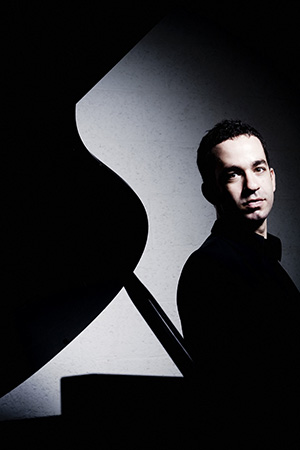Barnatan joins New World players for mostly Russian program

Inon Barnatan performed Shostakovich’s Piano Quintet Sunday with members of the New World Symphony. Photo: Marco Borggreve
The New World Symphony’s chamber program Sunday was called “Russian Gems.” One work wasn’t Russian, and not all the rest were gems. But the concert at New World Center in Miami Beach was a departure from the typical chamber performance, offering works for unusual combinations with a particular focus on wind instruments.
The concert opened with Stravinsky’s Eight Instrumental Miniatures, a piece the composer originally wrote for student pianists and later arranged for a 15-person ensemble of winds, horn and strings. An early product of his Neoclassical period, where he dropped the rich colors and big gestures of his popular ballets, this work is full of complex rhythms.
The New World musicians’ performance gave it crystalline textures, achieving a rich wind tone in the melodic passages, with particularly evocative playing by flutists Masha Popova and Allison Emerick. But possibly because the ensemble is about as large as it could get without a conductor, the performance came off as too straight, failing to convey the music’s zip and playful spirit.
Not many people have heard of Ludwig Thuille, a friend of Richard Strauss. For a work that’s hardly ever played, the Austrian composer’s Sextet for Piano and Winds is surprisingly appealing. Thuille’s style sounds a lot like Brahms, particularly the opening movement, with its rumbling piano and swelling wind melodies.
The New World players brought great warmth and unity of interpretation to the first movement, playing the spring-like melodies in a natural manner that let them breathe, and delivering the fleeting doses of taut drama. The Gavotte opened with a minor-key melody that achieved a humorous, mock-sinister tone in the solos of oboist Max Blair and bassoonist Sean Maree. Pianist Aya Yamamoto handled the complex part effectively, although her playing at time sounded tentative and could have used more sturdiness to undergird the wind players.
After intermission came a brief interlude for string quartet by Alfred Schnittke called Canon in Memory of Igor Stravinsky. Composed in 1971, the year of Stravinsky’s death, it is a grave and elegiac work that lasts just a few minutes. The New World musicians luxuriated in its slow-building tensions, which start with a single note that attracts a halo of dissonant harmony, allowing it to die off in rests before the music tries to rise again and finally grows silent.
Interesting as these musical odds and ends were, it was bracing to hear the Israeli pianist Inon Barnatan launch into the austere and striking opening melody of Shostakovich’s Piano Quintet in G Minor, Op. 57. The New World guest artist gave a performance that was riveting throughout, playing with hard-edged authority in brittle octave passages and smooth grace when accompanying the string players. The five musicians plunged into the drama of the Prelude while maintaining its essential formal tone, with its touches of Baroque style. The Fugue was built up effectively, growing from a few spare notes on unaccompanied violin.
There were occasional string intonation problems, but this didn’t detract unduly from a fine performance. The Scherzo powered along in a manner that was rhythmically driving, but with a light touch. Violinist Michael McCarthy achieved a real Shostakovich tone in his high, bleak solos in the Intermezzo and Finale, intense and never sentimental.
Posted in Performances
Leave a Comment
Mon Mar 21, 2016
at 1:21 pm
No Comments






